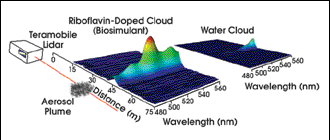



|
Photonics
TechnologyWorld
June 2004 Edition
|
Nonlinear Lidar Detects, Identifies Bio-Aerosols
As
world governments have grown more attentive to the potential threat of biological
weapons, a premium has been placed on developing technologies that can detect
and identify airborne pathogens. Such technologies also would be useful
for public health, spotting allergens and bacteria in the atmosphere. Now
a team of researchers from Université Claude Bernard Lyon 1 in Villeurbanne,
France, has demonstrated that two-photon-excitation lidar is suitable in
principle for the remote detection and identification of biological aerosols.
Currently, the favored approach for such detection
is polymerase chain reaction, said Jean-Pierre Wolf, a professor at the
university. Samples are collected in the field and returned to the lab for
analysis. This method, however, is time-consuming, and the results do not
easily yield information with which scientists can predict the spread of
a bio-aerosol.
 The
Teramobile nonlinear lidar system yielded a fluorescence signature for riboflavin
that was clearly different from that of pure water, indicating that the approach
should be suitable for the remote detection of bio-aerosols.
The
Teramobile nonlinear lidar system yielded a fluorescence signature for riboflavin
that was clearly different from that of pure water, indicating that the approach
should be suitable for the remote detection of bio-aerosols.
In theory, lidar
is an attractive tool for the detection and identification of these particles
in nearly real time. Microscopic biological materials can produce a backscattered
fluorescence signal that indicates their presence and their location in
three-dimensional space – relative to the lidar system – and that carries
characteristic spectral information enabling their identification.
Unfortunately, many interesting molecules in these
bio-aerosols, such as amino acids, are directly excited to fluoresce by
ultraviolet radiation, to which the atmosphere is relatively opaque because
of Rayleigh scattering and ozone absorption. The researchers, for example,
calculate that the detection limit of a lidar system using the best commercially
available 266-nm Nd:YAG laser would be on the order of only a few hundred
meters in a high-ozone urban environment.
Nonlinear lidar, in contrast, does not suffer from
this limitation. In the process, the biological molecule is excited to fluoresce
not by one high-energy photon, but by two lower-energy ones. Crucially,
the atmosphere is much more transparent at 530 nm, greatly increasing the
detection limit of a two-photon-excitation lidar system, in much the same
way that 800-nm excitation sources in two-photon microscopy exploit the lower
scattering by tissues in the near-IR to achieve better penetration than 400-nm
sources. The team estimates that a system employing frequency-doubled Nd:YAG
lasers (which would have to display pulsed performance better than is possible
today) would be capable of detecting tryptophan in bio-aerosols at concentrations
of 10 bacteria per cubic centimeter at a distance of 4 km in the typical
urban environment.
In a proof-of-principle demonstration of the technique,
the scientists induced fluorescence in plumes of 1-µm-diameter droplets
of an aqueous solution containing 0.02 g/l of riboflavin. As an excitation
source, they employed the Teramobile 5-TW mobile lidar system, which is
based on a Thales Optics chirped pulse amplified Ti:sapphire laser that
produces 80-fs pulses of 800-nm radiation at a repetition rate of 10 Hz.
Spectral data from the plume were collected from a distance of 45 m and displayed
a clear fluorescence signature for riboflavin.
Wolf said that the experiment illustrated the importance
of controlling the parameters of the excitation pulses. If the pulse were
too short, the fluorescence response would be lost in a white-light signal
generated in the air. If the pulse were too long, however, the on-target
intensity would be insufficient to induce fluorescence. In the work, 1-ps
pulses, corresponding to on-target intensities of 1011 W/cm2,
produced the best response.
A practical system will require an excitation source
that can produce similar intensities on the scale of kilometers but at a
wavelength of approximately 530 nm. Until such lasers emerge, the researchers
plan to continue their investigations, including studying pump-probe schemes
that would enable them to measure the size as well as composition of airborne
particles so that they may distinguish bio-aerosols and soot. 
by Daniel S. Burgess



 The
Teramobile nonlinear lidar system yielded a fluorescence signature for riboflavin
that was clearly different from that of pure water, indicating that the approach
should be suitable for the remote detection of bio-aerosols.
The
Teramobile nonlinear lidar system yielded a fluorescence signature for riboflavin
that was clearly different from that of pure water, indicating that the approach
should be suitable for the remote detection of bio-aerosols.